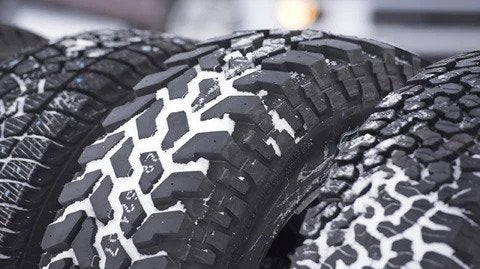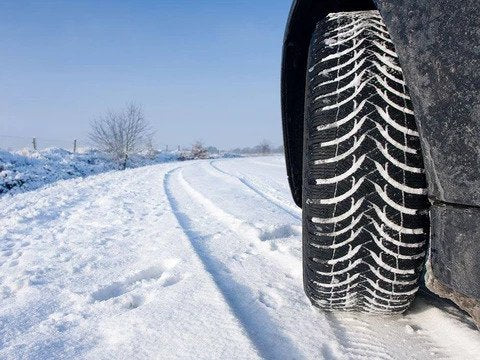 The cold is almost upon us, Leduc! Get your coats out, get your shovels ready, and make sure your Fords are winter-ready. Make sure your vehicle has winter tires so that you can be confident in safety, and performance of your automobile. Let's talk more below how winter tires can help your truck, SUV, or car.
The cold is almost upon us, Leduc! Get your coats out, get your shovels ready, and make sure your Fords are winter-ready. Make sure your vehicle has winter tires so that you can be confident in safety, and performance of your automobile. Let's talk more below how winter tires can help your truck, SUV, or car.
How do they work?
 Winter tires provide excellent braking and cornering in winter temperatures and conditions; ice, snow, slush, and dry cold asphalt. Winter tires aren't just made for the snow; they are made to adapt to Alberta's cold climate. When the thermometer dips to lower temperatures, regular tires begin to lose their road-holding ability, even on dry pavement. In comparison, winter tires are specially made to endure the frosty roads.
Winter tires provide excellent braking and cornering in winter temperatures and conditions; ice, snow, slush, and dry cold asphalt. Winter tires aren't just made for the snow; they are made to adapt to Alberta's cold climate. When the thermometer dips to lower temperatures, regular tires begin to lose their road-holding ability, even on dry pavement. In comparison, winter tires are specially made to endure the frosty roads.
What is the difference between winter tires and summer tires?
 At a quick look; a regular (or summer) tire might not look that different from a winter tire, but every aspect of a winter tire—from the materials to its design—is backed by science. Every feature is engineered to keep you safe on winter roads.
At a quick look; a regular (or summer) tire might not look that different from a winter tire, but every aspect of a winter tire—from the materials to its design—is backed by science. Every feature is engineered to keep you safe on winter roads.
 Let's start with the material. Winter tires are made with a different rubber compound than what is used in summer tires. It assists with gripping the road and plowing through the snow with no difficulty. Winter tires are required to stay soft and flexible so they can grip the road in cold temperatures. When the lower temperature hits, all-season tires become stiff, like a hockey puck sliding on ice, which significantly decreases their functionality. Winter tires, on the other hand, bend and grip snow like the soles of a winter boot. These tires contain silica, which provides friction and gives the rubber an edge to hold on to during the season of frosty roads. In some instances, winter tires are studdable; this provides the extra push necessary to tackle those icy roads. Mostly it is not required though, as many studless tires have a compound that contains crystal-like particles that act as built-in studs that perform the same function.
Let's start with the material. Winter tires are made with a different rubber compound than what is used in summer tires. It assists with gripping the road and plowing through the snow with no difficulty. Winter tires are required to stay soft and flexible so they can grip the road in cold temperatures. When the lower temperature hits, all-season tires become stiff, like a hockey puck sliding on ice, which significantly decreases their functionality. Winter tires, on the other hand, bend and grip snow like the soles of a winter boot. These tires contain silica, which provides friction and gives the rubber an edge to hold on to during the season of frosty roads. In some instances, winter tires are studdable; this provides the extra push necessary to tackle those icy roads. Mostly it is not required though, as many studless tires have a compound that contains crystal-like particles that act as built-in studs that perform the same function.
 Now let's move on to the design features that set winter tires apart. Hairline cuts in the tread of your tires displace water and grip snow. Winter tires have thousands of tiny crevices cut into the rubber of your winter tire to maximize traction on adverse surfaces; this process is called siping. On a summer tire, snow clogs and creates a slippery surface on winter roads, which decreases efficiency and safety on those tricky winter trips. A winter tire's siping pattern will sometimes also contain teeth so that even as the tread wears, the siping remains effective.
Now let's move on to the design features that set winter tires apart. Hairline cuts in the tread of your tires displace water and grip snow. Winter tires have thousands of tiny crevices cut into the rubber of your winter tire to maximize traction on adverse surfaces; this process is called siping. On a summer tire, snow clogs and creates a slippery surface on winter roads, which decreases efficiency and safety on those tricky winter trips. A winter tire's siping pattern will sometimes also contain teeth so that even as the tread wears, the siping remains effective.
Tread patterns are also what helps make your winter tires effective. Winter tires have a rougher look because of the tread design. Winter tire makers have a range of tread designs; from asymmetrical and arrowhead to v-shaped and staggered shoulders. It is meant to give you more traction by pushing away slush and snow, which helps exponentially in situations of tight braking or cornering. All-season tires or summer tires have a closed tread pattern for pushing away water and gripping roads through spring and summer. When faced with colder conditions, closed tread patterns can quickly clump with ice and snow, preventing the tire from adequately gripping the road.
What can winter tires do for you?
 Aside from the driving safety and peace of mind on those tricky winter Leduc roads, a set of winter tires will stop and steer better while prolonging the life of your Ford. An investment in winter tires is not only an investment in your comfort but also your safety. Ready for a tire change? Talk with your experts at DK Ford! You can contact us by phone at 780-986-2929, or visit us online.
Aside from the driving safety and peace of mind on those tricky winter Leduc roads, a set of winter tires will stop and steer better while prolonging the life of your Ford. An investment in winter tires is not only an investment in your comfort but also your safety. Ready for a tire change? Talk with your experts at DK Ford! You can contact us by phone at 780-986-2929, or visit us online.


























































